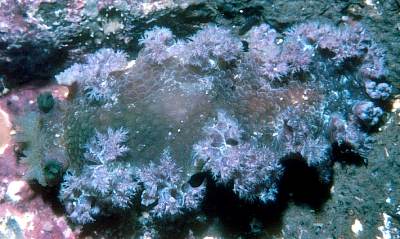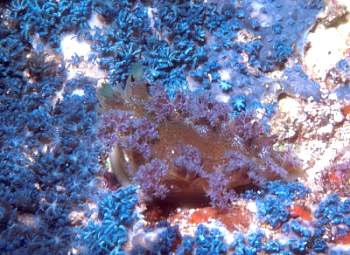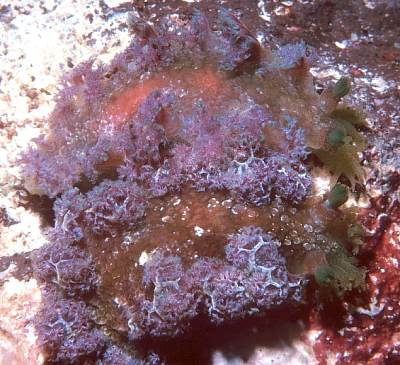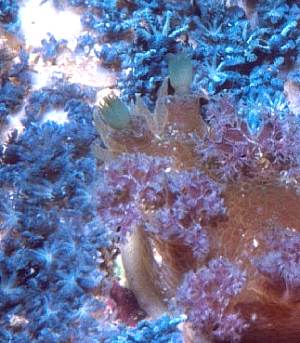

Marionia hawaiiensis
(Pease, 1860)
Order: NUDIBRANCHIA
Suborder: DENDRONOTINA
Family: Tritoniidae
DISTRIBUTION
Endemic to Hawaii
PHOTO
Upper: animal 50mm long alive. Lower photo shows an 26mm long individual on its food source, the Hawaii endemic soft coral Anthelia edmondsoni. Photos: Scott Johnson.
Body translucent orange brown with varying degrees of green pigmentation. The body is covered with low rounded tubercles each surrounded by a dark green ring, the rings forming a reticulate pattern all over the body. Often the green colouration extends over the tubercles and colours the rhinophores, oral veil and tentacles, and parts of the gills. There are seven finely branched gills on each side of the dorsum. They are a lighter colour than the mantle and tinged with pink or green. Grows to about 50m long. Feeds on the Hawaiian endemic soft coral Anthelia edmondsoni.
References:
• Kay, E.A. (1979) Hawaiian Marine Shells. Bernice P. Bishop Museum Special Publication 64(4): Honolulu
• Pease, W.H. (1860): Descriptions of new species of Mollusca from the Sandwich Islands. Proceedings of the Zoological Society of London, 28: 18-36.
Rudman, W.B., 2002 (November 24) Marionia hawaiiensis (Pease, 1860). [In] Sea Slug Forum. Australian Museum, Sydney. Available from http://www.seaslugforum.net/find/marihawa
Related messages
Marionia hawaiiensis
November 29, 2002
From: Scott Johnson


Hi Bill,
Attached are scans of a tritoniid from Hawaii. This has previously been reported as Tritonia hawaiiensis in most publications, including my own (Bertsch & Johnson, 1981). A more recent list of Hawaiian opisthobranchs put together by Cory Pittman and Pauline Fiene-Severns lists it as Marionia hawaiiensis, and I agree that it looks a lot more like a Marionia species I have found in the Marshalls as well as photos of Marionia species on the forum. Around the Hawaiian island of Oahu, I used to find these animals mostly in shallow water (3 meters or less) under boulders along the island's north and northwest coasts. These are the shorelines that get huge surf in the winter -- waves up to 15 meters and more tall -- and is the site of famous Hawaiian surfing beaches such as Pipeline, Sunset Beach, and Waimea Bay. A site a few hundred meters west of Waimea Bay had a nice population of M. hawaiiensis in the late 1970s. It is amazing they could survive the winter surf. In a second message there is a photo which shows an individual on its food source, the Hawaii endemic soft coral Anthelia edmondsoni. The animals in these photos range up to approx 50mm in length.
Scott
johnson@kmr.ll.mit.edu
Johnson, S., 2002 (Nov 29) Marionia hawaiiensis. [Message in] Sea Slug Forum. Australian Museum, Sydney. Available from http://www.seaslugforum.net/find/8493Thanks Scott,
Bill Rudman
Marionia hawaiiensis feeding
November 29, 2002
From: Scott Johnson


To accompany my first message here is a photo showing an individual on its food source, the Hawaii endemic soft coral Anthelia edmondsoni. The animal was 26mm long.
Best wishes,
Bill Rudman
johnson@kmr.ll.mit.edu
Johnson, S., 2002 (Nov 29) Marionia hawaiiensis feeding. [Message in] Sea Slug Forum. Australian Museum, Sydney. Available from http://www.seaslugforum.net/find/8504Thanks Scott,
Bill Rudman
